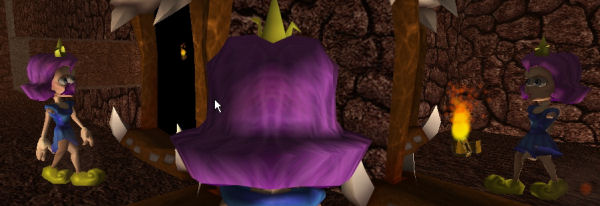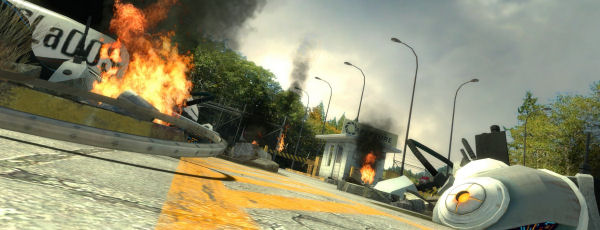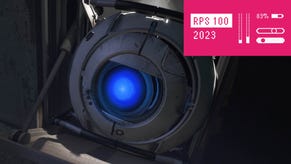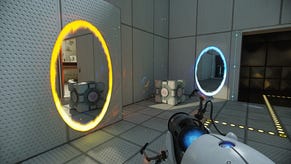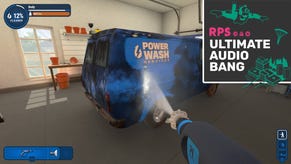RPS Interview: Portal's Kim Swift and Jeep Barnett
While visiting Valve a couple of weeks back, and shortly after completing Portal, I had the opportunity to natter with two of the leads on the game, Kim Swift and Jeep Barnett. We discussed the story - and the glee - of their arrival at Valve, how it was fitting in and creating their first professional game, and, as you might expect, Weighted Companion Cubes. (We're assuming you've already finished Portal here, spoiler chums).
RPS: Tell us about that day when Valve visited the Digipen expo.
Kim Swift: Every year Digipen holds an expo for graduating seniors, and all of us on the Portal team were all going to school together. And we made a game called Narbacular Drop for our senior project. During the expo, Digipen grabs a whole bunch of developers from across the country to come in and take a look at student’s projects. A couple of people from Valve came by and took a look at our game, and first they told us everything that we did wrong with it. But then at the end they said, “This is an interesting concept,” and gave us some business cards. We called them back, and they invited us in to show the game to a bunch of employees here at Valve, as well as Gabe Newell, and after about fifteen minutes through our presentation Gabe stopped everyone in the room from talking and asked us what we were going to do after we graduate. And offered us a job to come in and make Portal. So we immediately said, “Oh my God, are you kidding? Yes!” We went outside and stared at each other for about twenty, thirty minutes, just not believing our luck.
RPS: It’s like a fairytale.
KS: Yeah, sometimes it feels like a dream. Like, did that actually happen? It’s so crazy.
RPS: When you were developing Narbacular, did you know what you were on to?
Jeep Barnett: Yeah, when we started it we wanted to make something really unique and special, something that would stand out from whatever existed at the time. I think as we got close to the end we were thinking yeah, it’s working…
KS: Yeah, but we didn’t know how well it would work!
JB: Oh no, we didn’t know it would get us to Valve!
KS: The whole point of making that game is to have something good on our resumes that will get us a job. And we had no idea how good of a job it would get us.
JB: Yeah, we were happy with the game at the end of the year, but we were all pretty much splitting up, going our separate ways, some of us had jobs in other places. Then Valve were like, “No, do it again!”
RPS: So what did Valve say was wrong with Narbacular?
JB: One thing I remember in particular… In Narbacular Drop there’s a lot of cases where we have places where you can screw yourself. You can drop your box in the lava and you have to reset the level. And in Valve design terms, that’s retarded. You can’t screw the player. That was one big thing that came up. The art design – everything was pretty brown and muddy. So when people first see the game they say…
KS: Quake.
JB: Yeah, it’s a first-person shooter. So there were a lot of things that we did wrong in that sense. You couldn’t tell the ceiling from the floor, there was no grounding in reality.
RPS: Did the whole team stay together?
KS: Yeah, we all came. All seven of us.
RPS: How was it integrating into Valve?
KS: It was a little tricky at first. We’re in this amazing company, everyone here is so smart, and they’re ten-year industry veterans. And here we are, the little kids. But it was really great, everyone here was incredibly supportive, and willing to help us out and get adjusted.
JB: For Narbacular Drop we’d been working with our own code, so starting to get integrated with the Source engine was pretty tricky at first. I think after jumping in at the deep end, we kind of figured it out. Whenever we were like, “How does this work?”, or “How can we do something like this with the physics engine?” there was some genius who would say, “Here’s how you do it!” A lot of osmosis.
RPS: Do you consider Valve to be a philanthropic company? Are they going out of their way to be nice, to help? Or is it just good business sense? Bringing in a team fresh from college – that seems like a big risk?
KS: I think they know potential. It’s something that they’ve done in the past. They brought in the Team Fortress guys, they brought in the Counter-Strike guys, Day of Defeat. So many people here are from mod teams that it seemed like a reasonable jump for Valve to bring in a team from school. We were doing basically the same thing – we were working in a team, and we created a game. I think they just can see what’s going to come next.
JB: It started out as an experiment too. They said, “Start working and we’ll see what happens.” I’m sure if we’d done badly, they’d have fired us. [laughs] They just wanted us to produce something on the same level as we did before. And it worked.
RPS: What’s Valve’s motivation in your eyes? They’ve got lots of money, they don’t have to please publishers or shareholders, so what’s the motivation to keep making games?
KS: Hopefully they enjoy making games. I think everyone gets into an entertainment industry because they enjoy it. I know walking down the hallways that everyone loves their job, they’re glad to be here. I guess I can’t really see Valve doing anything else.
JB: They just look at what’s out there and say, “What aren’t games doing?” “Why aren’t they doing it?” “Can’t we do this for pretty cheap? Why don’t we do it?” And they do. They’re trying to push things forward.
KS: At the same time, we’re in an entertainment industry. If you don’t make money, how are we going to keep making games, so there’s a flipside to that.
JB: I think you’re kind of right though. Like the Introversion stuff, with Darwinia and their games, they just picked them up and said, “Hey, you guys should sell this.” And Ragdoll Kung Fu, and all these little games they put on Steam. I think they want to see people doing good work succeed. People sometimes slip under the radar, and I think they want to see them do well.
RPS: One thing that stood out in Narbacular, and again in Portal, was how quickly this completely new mechanism works its way into your brain. How did you go about designing it this way?
KS: We initially found the opposite for Narbacular Drop. We found that people got really, really confused, and were put off by the game at first. Not enough people stuck with it. So we were really deliberate about training our players in Portal. We start them off nice and slow, and give them a gradual ramp up of abilities that we teach them how to use. We found that people are a lot happier with that.
JB: Try to imagine a bunch of engineers inside your brain trying to hook up the pipes, where do they hook up? And eventually you’ll see something, like you’ll see yourself in a portal, or you’ll see some momentum, and all of a sudden, we hooked it up. I think in Portal we’re much more deliberate about setting up those set pieces that let people understand what’s happening.
RPS: Someone asked me about Portal, asking if it gets more difficult. I said, it doesn’t get more difficult – you just get better at it. That sense of progression – how did you go about creating it?
KS: Play-testing. A lot. We started play-testing our game literally the first week that we got here. That one room that you wake up in – we had that built in a couple of days, and we immediately started play-testing it. That room is deliberately laid out so that you look at all the props in the room, you get acquainted, so that way when you walk through the portal for the first time, you see that you came out in the same room, you see all the same props you were playing with...
RPS: Dropping down the toilet.
KS: Exactly. So it’s that sort of reiteration that we used with every single level, so that the learning curve was nice and smooth. Watching someone play through the game, it’s very clear what works and what doesn’t. You can be very objective about your work just by watching someone play.
JB: If something about a puzzle’s unfair, it’s immediately obvious. In terms of making a new level, we look at what levels we already have, what skills is the player guaranteed to have because of the levels he’s already completed, and what new can we add to that.
RPS: In the movie industry, test screenings can destroy films, but in this industry it seems that Valve’s play-testing cam dramatically improve games.
KS: I think it’s the process. As far as screen-testing goes, it’s usually not until the end of the movie process. We started testing as soon as we got here. And I can understand how it would destroy a movie, because it kind of did that for Narbacular Drop. We didn’t start play-testing until really the last month of our development, and by that point it’s too late to do anything about it. It’s like, “Oh, well, that’s unfortunate.” I think it’s when you start to get user feedback that’s most important. Because we’re in an entertainment industry, and if people are not entertained, then we’re not doing our job.
JB: We tried to develop things from the player’s perspective. If you throw in twenty weapons and the player only uses one, then you only needed to make that one weapon in the first place. And if you find that out before you’ve made the other twenty weapons, then you’ve saved money.
RPS: Is there ever a danger of dumbing down as a result of that.
KS: Well, one of the things we’ve done is to create the advanced chambers and challenge maps. There’s ways to interest players that are a lot ‘quicker’ than some of our other players. I think there’s a good balance that you can find.
JB: Things still start on a whiteboard. You think, “What would be a cool idea,” and then present it to a player and find out what was wrong with the idea. No matter how cool the idea, if they didn’t understand it, then it wasn’t a cool idea.
RPS: What do you consider Portal’s role in the Orange Box?
KS: Well, it’s definitely a bonus content thing. It’s a shorter game than the others. I guess it’s Valve’s way of experimenting, and trying something that as a company they’ve never done before. We had a short little game with an experimental gameplay concept, so I guess it’s testing the waters.
JB: One thing somebody else told me was that Half-Life 2 was split between action and puzzle solving. And TF2 was all action. And Portal is all puzzle solving! It’s the counter-balance for TF2.
RPS: Was the integration with the Half-Life universe a necessity for having it be in there? Was that something you needed to do to justify the game, or something that aided the game development itself?
KS: It’s something we wanted to do. We were all big Valve fans before we came here, and so given the opportunity to put our game in the Half-Life universe was like, YES!
RPS: I don’t know whether I missed the obvious, or if I’m on the right track, but I felt like Aperture, in competition with Black Mesa, must have got the contract to build the equipment for the enemies in Half-Life?
KS: It’s not something we can really comment on I guess.
JB: A lot’s left up to interpretation. When people ask us what the story is, we ask everybody on the team, and we all have a different take on it.
RPS: So creating that story, how did you work with the writers during development?
KS: Well, we started with the gameplay, and decided that we needed some sort of player reward, and we thought having some sort of a story, and having something talk to you, while you’re playing the game, would be a good thing. So we talked to Chet and Erik – the Old Man Murray guys, and Erik of course did half the writing on Psychonauts – and Erik had this idea of this dark humour robotic voice talking to you throughout the game. He wrote us some sample dialogue, and we absolutely loved it. So we said, “This is perfect. Just go crazy.” And whenever we would playtest the game with the dialogue in people would really enjoy it. People would stop what they were doing to listen to her speak, and felt really rewarded by it. The more we playtested the game, the more people found her important, and she became a full-fledged character.
RPS: Did the ending come about because of people’s enjoyment of the character?
KS: We wanted to have some sort of boss battle, but it was really apparent to us that you should meet GLaDOS. She’s talking to you the entire time, and everyone’s curious, what does she look like? What is she? Is she a person? Is she really a robot? So we wanted to reward players.
RPS: At what point did you know you were going to have a song?
KS: [laughs] Toward the end of our development we were thinking, what would be a nice ending that would send players off feeling good and happy? I was in contact with Jonathan Coulton, who wrote our song, and I suggested to Gabe that we hire him to write some songs for us, as his demographic is similar to ours. Gabe thought that was an interesting idea, and I talked to Erik about it, and he apparently had this dream goal. His life ambition was to work on a game with a song at the end. So we decided, we were going to put a song at the end of Portal.
RPS: At RPS, we love games with songs in. As I was playing it, I immediately IMd one of the guys saying, “We’ve got a number 1!” Although admittedly there’s not much competition beyond Boiling Point.
JB: There’s God Hand! Erik talks about that one. "God Hand has the greatest song."
RPS: How did you go about creating the character of GLaDOS with Ellen McLain?
KS: We needed a female voice to do the speaking, and Ellen’s done a lot of voice acting at Valve before – she was the Overwatch voice in HL2, and does the announcing in TF2 – so we figured she’d be a good person to go with. She’s a great sport, and she really enjoyed the character and the humour. She said it’s the first videogame that she’s ever wanted to play. So we told her, we want you to sing a song for us Ellen? And man, she was so excited. She’s a classically trained operatic soprano, so when we told her we wanted her to sing, she was just so happy.
RPS: Even from the very beginning, it’s surprisingly dark. That beginning room you described – that’s basically a prison cell.
KS: Well, the whole story is that you’re this rat in a maze. So what better than thing to do than start the rat off in a cage?
JB: When the player starts in the character’s head, they don’t know anything about the world. You can assume that the character doesn’t know about the world, and when you put those two together, it helps you relate to the environment better. So you ask, why am I here? Why am I trapped?
RPS: You then play on this “amnesia” opening, with GLaDOS suggesting things like I might be an android.
KS: Well, as far as the android thing goes, that was a joke. We wanted to joke around and say that this particular test chamber wasn’t actually meant for real humans. But the further you get, GLaDOS takes a bit more notice of you. When you first start the game, she basically plays pre-recorded versions of herself to talk to you. And later she really starts to notice you, and wonders why you’re doing so well, and starts to set up obstacles to stop you. That’s kind of why she drops you into a room that’s meant for military androids.
JB: And again, it’s up to interpretation. Early on in the game there’s a lot of places where it’s obvious that she’s lying to you. So the fact that she lies that early on makes you have to question what things are true, and what’s not true, that she tells you.
RPS: You only ever explain in order to confuse.
KS: [laughs] Isn’t that the Valve way though?
RPS: So you’re probably going to go down in history as the first game to give what’s essentially a crate a character. What on earth was going on behind that design decision?
JB: Well, we really wanted to make a level, which we call internally, “The Box Marathon.” We wanted a level where you take a box from the beginning to the end, and it helps you solve all the puzzles. In doing that, in play-testing people got to the end of the chamber and said, “Aw, I have to leave my cube behind!” And we started to pick up on that. We though, “Man, we should make this cube more interesting.”
KS: Exactly. So we just kept taking it one step further. So Erik added the dialogue, and then I changed the cube to have a heart on it, until it became this elaborate character.
RPS: The heart was a really clever idea, because it means you identify with that scene at the end with the cake, and there’s that cube with a heart on it. And I found myself feeling affection – but it’s just a cube.
JB: It’s funny, my wife’s playing through the game now, and she’s halfway through, and she’s poking at night, and I’m like, “What?” and she’s says, “Does that cube come back?”
RPS: The commentaries say that at one point the turret ambush was intended to be the end of the game?
JB: Yes, we did a lot of iterations of the boss battle. At one point the boss battle was going to be in that room. The turrets would appear as you were fighting the boss.
RPS: So why did that not survive?
KS: It wasn’t fun. [laughs] We played it – it wasn’t fun. Pretty much all of our decisions come down to, is this fun? Our play-tester feedback would tell us this. Those particular rooms just went through so many iterations, and tweaking to find the right balance, and eventually we came to something that we thought was actually fun, and stuck with it. We want people to see the ending of our game, because we love the ending of our game, so we had to make sure that players were having a good time.
RPS: There’s a very feminine tone to Portal. Was that a deliberate response to the very masculine world of games?
KS: I dunno. As far as the player character goes, we figured, why not? There aren’t really any female protagonists in the Valve series that you play as. And GLaDOS – I’m not sure how we chose GLaDOS to be a girl.
JB: I think we had the voice actor first. We were like, "Who can do a robot voice?"
KS: Oh, that’s right! Because we were using the Overwatch voice from Half-Life 2 to test stuff out, and we liked the tone of it.
JB: I think from there it was pushing on a theme. Once we had the protagonist and the antagonist set up, it pushed the rest of it.
RPS: Portal seems to appeal beyond the normal demographic of gaming.
KS: Well, one the thing we’ve noticed is that a lot of different types of people enjoy playing our game. We’ve had hardcore Counter-Strike players come in and have a good time. We’ve had people’s wives come in and have a really good time. Gabe’s kids are our number one play-testers of our game, and they absolutely love it. And they’re eight years old. I don’t know if it’s something we’ve deliberately done, but apparently we’ve done a decent job at making our game one that anyone can play and have a good time.
JB: I think that what’s interesting is that when the trailer first came out and it went on YouTube, it got so many hits, we were like, “Who are these people watching our trailer?!” So it seems like there is a wider audience out there who are interested in the game.
RPS: So what about a Wii version? That’s similarly tapping into the wider audience.
KS: I know we’re all really big fans of the Wii at Valve, but who’s to say? It’s would be a fair amount of work to get the Source engine onto the Wii.
RPS: Do you keep in touch with the indie scene?
KS: It’s always good to keep a look out at what’s happening in the industry, both indie and mainstream, just to see if there is something interesting out there. It’s something Valve does every GDC [Games Developers’ Conference], we always look at those student showcases, and the indie areas.
JB: And whenever interesting little Flash games come up they get emailed around, people saying why they’re interesting.
RPS: So do you think you might ever be able to hire the next ‘you’?
KS: Maybe. It would be nice to give back! Like, karma.
JB: It would be nice to not be the new guys. [laughs]
RPS: What do you guys do next?
KS: We’re not even sure yet. This is our first professional game. We want to release it, and see what people think. We think it’s really great, but who’s to say that most the population will think it’s great. We want to see what the community has to say, do they want Portal multiplayer, do they want Portal 2, do they want new map packs? Keeping our ear to the ground.


